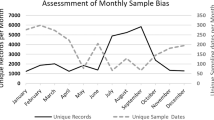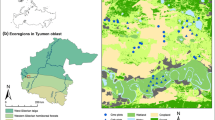Abstract
We present the results of a rapid assessment of butterfly diversity in the 754 ha Beaver Meadows study area in Rocky Mountain National Park, Larimer County, Colorado. We measured butterfly species richness and relative abundance as part of a landscape-scale investigation of diversity patterns involving several groups of organisms. A stratified random sampling design was used to include replication in both rare and common vegetation types. We recorded 49 butterfly species from the twenty-four 0.1 ha plots that were sampled four times during June, July, and August 1996. Butterfly species richness, diversity, and uniqueness were highest in quaking aspen (Populus tremuloides Michaux) groves and wet meadows, which occupy only a small proportion of the studied landscape. This result supports the suggestion that aspen areas represent ‘hotspots’ of biological diversity in this montane landscape. Patterns of butterfly species richness were positively correlated with total vascular plant species richness (r = 0.69; P < 0.001), and native plant species richness (r = 0.64; P < 0.001). However, exotic plant species richness (r = 0.70; P < 0.001) and the cover of exotic plant species (r = 0.70; P < 0.001) were the best predictors of butterfly species richness.
Similar content being viewed by others
References
Baker WL,Munroe JA andHessl AE (1997) The effects of elk on aspen in the winter range in Rocky Mountain National Park. Ecography 20: 155-165
Blair RB andLauner AE (1997) Butterfly diversity and human land use: Species assemblages along an urban gradient. Biological Conservation 80: 113-125
Buchholtz CW (1983) Rocky Mountain National Park: A History. Colorado University Associated Press, Boulder, Colorado
Burd M (1994) Bateman' principle and plant reproduction: The role of pollinator limitation in fruit and seed set. The Botanical Review 60(1): 83-111
Carter JL (1988) Trees and Shrubs of Colorado. Johnson Books, Boulder, Colorado Colorado Natural Heritage Program (1997) Rare and Imperiled Animals, Plants and Natural Communities. Vol 3, No 1. Colorado State University, Fort Collins, Colorado
DeByle NV (1985) Wildlife. In: DeByle NV andWinokur RP (eds) Aspen: Ecology and Management in the Western United States, pp 135-152. USDA Forest Service Technical Report RM-119, Fort Collins, Colorado
Ehrlich PR andRaven PH (1964) Butterflies and plants: A study in coevolution. Evolution. 18: 586-608
Erhardt A (1985) Diurnal Lepidoptera: Sensitive indicators of cultivated and abandoned grassland. Journal of Applied Ecology 22: 849-861
Ferris CD andBrown FM (eds) (1981) Butterflies of the Rocky Mountain States. University of Oklahoma Press, Norman, Oklahoma
Forman RT (1995) Land Mosaics: The Ecology of Landscapes and Regions. Cambridge University Press, Cambridge, UK
Gaston KJ (1994) Rarity. Population and Community Biology Series 13. Chapman & Hall, London
Gutierrez D (1997) Importance of historical factors on species richness and composition of butterfly assemblages (Lepidoptera: Rhopalocera) in a northern Iberian mountain range. Journal of Biogeography 24: 77-88
Heimann B andCussans GW (1996) The importance of seeds and sexual reproduction in the population biology of Cirsium arvense: A literature review. Weed Research 36: 493-503
Jones JR (1985) Distribution. In: DeByle NV andWinokur RP (eds) Aspen: Ecology and Management in the Western United States, pp 9-10. USDA Forest Service Technical Report RM-119, Fort Collins, Colorado
Jones JR,DeByle NV andBowers DM (1985a) Insects and other invertebrates. In: DeByle NV andWinokur RP (eds) Aspen: Ecology and Management in the Western United States, pp 107-114. USDA Forest Service Technical Report RM-119, Fort Collins, Colorado
Jones JR,Kaufmann MR andRichardson EA (1985b) Effects of water and temperature. In: DeByle NV andWinokur RP (eds) Aspen: Ecology and Management in theWestern United States, pp 71-76. USDA Forest Service Technical Report RM-119, Fort Collins, Colorado
Jongman RHG,ter Braak CJF andvan Tongeren OFR (eds) (1987) Data Analysis in Community and Landscape Ecology. Pudoc, Wageningen, The Netherlands Kim KC (1993) Biodiversity, conservation, and inventory: Why insects matter. Biodiversity and Conservation 2: 191-214
Krebs CJ (1989) Ecological Methodology. Harper and Row, New York
Kremen C (1992) Assessing the indicator properties of species assemblages for natural areas monitoring. Ecological Applications 2: 203-217
La Roe ET (1995) Biodiversity: A new challenge. In: LaRoe ET,Farris GS,Puckett CE,Doran PD andMac MJ (eds) Our Living Resources: A Report to the Nation on the Distribution, Abundance and Health of US Plants, Animals and Ecosystems, pp 6-7. United States Department of the Interior, National Biological Service, Washington, DC
Leps J andSpitzer K (1990) Ecological determinants of butterfly communities (Lepidoptera, Papilionidae) in the Tam Dao Mountains, Vietnam. Acta Entomologica Bohemoslovaca 87: 182-194
Li HW (1995) Non-native species: Overview. In: LaRoe ET,Farris GS,Puckett CE,Doran PD andMac MJ (eds) Our Living Resources: A Report to the Nation on the Distribution, Abundance and Health of US Plants, Animals and Ecosystems, pp 427-428. United States Department of the Interior, National Biological Service, Washington, DC
Ludwig JA andReynolds JF (1988) Statistical Ecology. John Wiley and Sons, New York
Magurran AE (1988) Ecological Diversity and its Measurement. Princeton University Press, Princeton, New Jersey
Master LL (1991) Assessing threats and setting priorities for conservation. Conservation Biology 5: 559-563
Molina JM andPalma JM (1996) Butterfly diversity and rarity within selected habitats of western Andalusia, Spain (Lepidoptera: Papilionoidea and Hesperioidea). Nota Lepidopterologica 78: 267-280
Mueggler WF (1985) Vegetation associations. In: DeByle NV andWinokur RP (eds) Aspen: Ecology and Management in the Western United States, pp 45-55. USDA Forest Service Technical Report RM-119, Fort Collins, Colorado
Murphy DD andWilcox BA (1986) Butterfly diversity in natural habitat fragments: a test of the validity of vertebrate-based management. In: Verner J,Morrison JL andRalph CJ (eds) Wildlife 2000: Modeling Habitat Relationships of Terrestrial Vertebrates, pp 287-292. The University of Wisconsin Press, Madison, Wisconsin
Nelson SM andAndersen DC (1994) An assessment of riparian environmental quality by using butterflies and disturbance susceptibility scores. The Southwestern Naturalist 39: 137-142
New TR (1991) Butterfly Conservation. Oxford University Press, South Melbourne, Australia
New TR,Pyle RM,Thomas JA,Thomas CD andHammond PC (1995) Butterfly conservation management. Annual Review of Entomology 40: 57-83
Noss R (1983) A regional landscape approach to maintain diversity. Bioscience 33: 700-706
Opler PA,Bray RA andSimonson SE (1997) Butterflies of Rocky Mountain National Park. List prepared for the National Park Service. United States Department of Interior, Washington, DC
Opler PA andKrizek GO (1984) Butterflies East of the Great Plains. John Hopkins University Press, Baltimore, Maryland
Opler PA (1999) A Field Guide to Western Butterflies. Houghton Mifflin, New York
Parmesan C (1996) Climate and species range. Nature 382: 765-766
Peet RK (1981) Forest vegetation of the Colorado Front Range. Vegetatio 45: 3-75
Pollard E andYates TJ (1993) Monitoring Butterflies for Ecology and Conservation. Chapman & Hall, London
Powell JA (1994) Biogeography of Lepidoptera on the California Channel Islands. In: Halverson WL andMoender GJ (eds) The Fourth California Islands Symposium Update on the Status of Resources, pp 449-463. Santa Barbara Museum of Natural History, Santa Barbara, California
Powell SD,Grant JF andLambdin PL (1995) Incidence of above-ground arthropod species on musk thistle in Tennessee. Journal of Agricultural Entomology 13: 17-29
Riepe D andToborg B (1996) Butterflies and moths of national parks, state parks, and national wildlife refuges. A survey reflects a growing interest in managing for Lepidoptera. National Park Service, United States Department of the Interior. Park Science 16(4): 15-18
Samways MJ (1994) Insect Conservation Biology. Chapman & Hall, London
Scoble MJ (1992) The Lepidoptera: Form, Function and Diversity. Oxford University Press, New York
Scott JA (1968) Hilltopping as a mating mechanism to aid the survival of low density species. Journal of the Research on the Lepidoptera 7: 191-204
Scott JA (1986) The Butterflies of North America. Stanford University Press, Stanford, California
Scott JA (1992) Hostplant records for butterflies and skippers (mostly from Colorado) 1959-1991, with new life histories and notes on oviposition, immatures, and ecology. Papilio 6: 1-170
Simonson SE (1998) Rapid Assessment of Butterfly Diversity: A Method for Landscape Evaluation. Unpublished MS thesis. Colorado State University, Fort Collins, Colorado
Sparks TH,Greatorex-Davies JN,Mountford JO,Hall ML andMarrs RH (1996) The effects of shade on the plant communities of rides in plantation woodland and implications for butterfly conservation. Forest Ecology and Management 80: 197-207
Spitzer K,Jaros J,Havelka J andLeps J (1997) Effect of small-scale disturbance on butterfly communities of an Indochinese montane rainforest. Biological Conservation 80: 9-15
SPSS (1996) Systat 7.0 for Windows. SPSS Inc, Chicago
Stohlgren TJ,Faulkner MB andSchell LD (1995) A modified-Whittaker nested vegetation sampling method. Vegetatio 117: 113-121
Stohlgren TJ andBachand RR (1997) Lodgepole pine (Pinus contorta) ecotones in Rocky Mountain National Park, Colorado, USA. Ecology 78: 632-641
Stohlgren TJ,Chong GW,Kalkhan MA andSchell LD (1997) Multi-scale sampling of plant diversity: effects of minimum mapping unit size. Ecological Applications 7(3): 1064-1074
Stohlgren TJ,Binkley D,Chong GW,Kalkhan MA,Schell LD,Bull KA,Otsuki Y,Newman G,Bashkin M andSon Y (1999) Exotic plant species invade hot spots of native plant diversity. Ecological Monographs 69(1): 25-46
Strong DR,Lawton JH andSouthwood SR (1984) Insects on Plants: Community Patterns and Mechanisms. Harvard University Press, Cambridge, Massachusetts
Suzuki K (1997) Aspen Regeneration in Elk Winter Range of Rocky Mountain National Park and Roosevelt National Forest, Colorado. Unpublished MS thesis. Colorado State University, Fort Collins, Colorado
Swengel AB (1996) Effects of fire and hay management on abundance of prairie butterflies. Biological Conservation 85(2): 73-85
Thomas CD andMalorie HC (1985) Rarity, species richness, and conservation: Butterflies of the atlas mountains in Morocco. Biological Conservation 33: 95-117
Turchi GM,Kennedy PL,Urban D andHein D (1995) Bird species richness in relation to isolation of aspen habitats. Wilson Bulletin 107(3): 463-474
Turner MG,O'Neill RV,Gardner RH andMilne BT (1989) Effects of changing spatial scale on the analysis of landscape pattern. Landscape Ecology 3: 153-162
Veblen TT andLorenz DC (1991) The Colorado Front Range: a Century of Change. University of Utah Press, Salt Lake City, Utah
Whittaker RH (1952) A study of summer foliage insect communities in the Great Smoky Mountains. Ecological Monographs 22: 1-44
Wood PA andSamways MJ (1992) Landscape element pattern and continuity of butterfly flight paths in an ecologically landscaped botanic garden, Natal, South Africa. Biological Conservation 58: 149-166.
Zar JH (1974) Biostatistical Analysis. Prentice Hall, Engelwood Cliffs, New Jersey
Author information
Authors and Affiliations
Rights and permissions
About this article
Cite this article
Simonson, S.E., Opler, P.A., Stohlgren, T.J. et al. Rapid assessment of butterfly diversity in a montane landscape. Biodiversity and Conservation 10, 1369–1386 (2001). https://doi.org/10.1023/A:1016663931882
Issue Date:
DOI: https://doi.org/10.1023/A:1016663931882




